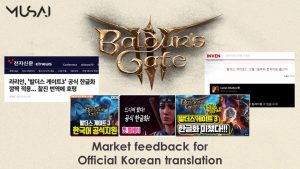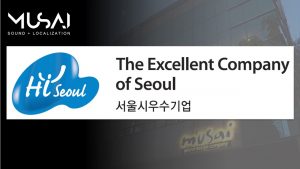The major language combination for Korean Game publishers and developers.

Major Korean Language combination in L10n industry
The last article reviewed the overall situation of the Korean game market. This time, we will narrow down our focus on the L10n industry. Let’s find out in which languages Korean developers and publishers mainly do localization.
See also: The Distinct Characteristics of the Korean Game Market
* I tried to be as objective as possible, but it may be a little different from the real status of the industry as it was written based on my personal experiences. Thanks for your understanding!
Below is the summary of the major game platform of game publishers/developers, the main target languages, and their status of in-house resources for L10n.
Table 1. The major game platform of Game Publishers/Developers

Table 2. The Main Target Languages of L10n

Table 3. The Status of In-house Resources for L10n

The language-specific characteristics of the localization are as follows:
1. Korean to English: The most basic language combination.
- Most Koreans learn English from a young age. Some even begin to learn English after entering kindergarten. Thus, most Korean adults speak and understand a certain level of English
- Therefore, when the translation from Korean to English is completed, reviewers who speak English at an intermediate level, instead of a native English speaker, could review the translation. Of course, what matters the most in localization is to respect the client’s opinion. However, sometimes L10n agency has to prepare detail counter-feedbacks to convey linguists’ intentions, thereby maintaining the quality of localized asset you did. A customer is always right but sometimes…
2. Korean to Simplified Chinese: A language combination with great market potential. But need to keep an eye on the Chinese government’s policy.
- Significantly influenced by the Chinese government’s policy (i.e. issuance of service license). In 2017 and 2018, the volume of localization projects from Korean to Simplified Chines was greatly reduced when the Chinese government shutting down all global games into China market. (But there’s some news they started give license from March slowly.)
- Once the Chinese game market is open, the demand for localization is projected to grow as the number of Korean publishers seeking to enter the market increases and Chinese publishers to purchase publishing rights for Korean IP games will both increase.
- However, competition is expected to intensify as the unit costs of Chinese L10n agencies are often lower than those of Korean agencies in terms of Korean to simplified Chinese and vice versa.
3. Simplified Chinese to Korean: A language combination with the fastest growing market size.
- The volume of projects has increased the most for the last three years as quality of Chinese games has improved and its exports has increased.
- Usually collaborate with a Korean publisher, who hold domestic copyrights, or establish their own branches in Korea because China is geographically close to Korea.
- Many Chinese game developers do not consider localization into the account at the development stage. As a result, source files and context information required for localization are often not organized. In view of this, L10n agencies need to make sure that they have enough personnel and schedule at the pre-localization stage.
- Chinese developers prefer their Chinese to English when communicating. Also highly recommend assign Chinese native (or even someone who has experience of Chinese business culture), it’s much different from Western or even Japan and South Korea.
4. Korean to Japanese: Should consider the distinct characteristics of the Japanese game market.
- Due to the unique characteristics of the Japanese game market, games, the games usually localized when targeting on the Japanese market from the beginning.
- Considering the cost of localization, it is better to do localization in Korea than in Japan.
- Japanese game users tend to care about details. Thus, L10n agencies should make special efforts to maintain a certain level of localization quality unlike other languages. (e.g. review by native speakers, LQA, fun QA and etc.)
5. Japanese to Korean: Plenty of resources available, but not many projects than you expected.
- Many L10n resources (translators, editors, testers…) are available in Korea.
- Similar as Korean to Japanese, clients usually prefer Korean agencies in consideration of the unit price of localization.
- In case of console games, the Japanese game publishing business for Korean market has become fully established (e.g. branch office, distribution, outsourcing and etc). For this reason, clients often have localization agencies or linguists with whom they’ve worked for a long time. And they tend not to change their partners often except critical issue. As a result, it’s difficult for newly-established agencies to enter the market.
6. English into Multi-Languages:
- Main targets among European languages: FIGS, RUS
- Main targets among SEA languages: Thai, Malaysian, Vietnamese
- As for SEA languages, sometimes few customers want to do from Korean to SEA languages directly. It’s doable but please do consider there are a really limited verified linguistic resources. So some agencies try to hire amateur resources for draft translation and proof-read by each language natives.
- LATAM: LAS, BPO
- In large clients, L10n managers’ have a high understanding of the L10n industry as well as translation skills. The large client has dedicated L10n managers and they have their own process, bidding system, STD rate policy. Thus, multilingual localization should be done in a way that is optimized for each client and project from RFP stage.
Other Things to Consider When Doing Localization with Korean Clients
- Localization Engineering
- Translation source files may not be well organized. Thus, L10n agencies should assign enough time to create bilingual files for TEP.
- Also, if there any information essential for localization, the L10n agency should summarize and request what is needed. Otherwise, they may give source text only especially they don’t have much experience for L10n.
- Agencies should note that it takes quite some time to organize source files and to confirm relevant information
- Communication
- Generally, L10n managers of clients can communicate in English, but prefers Korean of course.
- Only a few large clients have a style guide or other instruction for localization. L10n agencies should create those materials and checklist and ask confirmation before beginning the localization.
- Payment Process
- Large clients can issue invoices for overseas, but small and midsized clients prefer to issue their Korean tax invoice.
If you have any questions or needs any consultation related to Korean, please contact us via info@musaikorea.com.
BOOST YOUR PLAY! Musai Studio








1 thought on “The major language combination for Korean Game publishers and developers.”